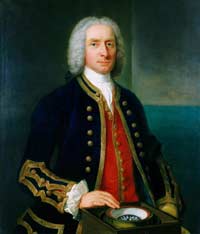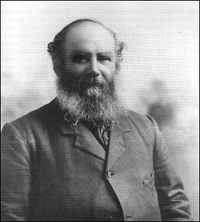
|
Civil Magistracy This history of the Newfoundland magistracy begins with the first appointment of local justices of the peace in 1729. From the outset the British government tried to address the apparent dearth of formal legal training and institutions in Newfoundland. Raised initially in the Privy Council, a proposal to send guidebooks to accompany the new commissions of the peace was eagerly adopted by the Board of Trade. Before sailing from Spithead, the Newfoundland squadron took aboard 13 copies of King William's Act, one bundle of the acts relating to Trade and Navigation, as well as 11 sets of Shaw's Practical Justice of the Peace. Each copy of the manual had the name of one of the island's principal towns embossed in gold letters on the cover. When Governor Henry Osborne arrived in HMS Squirrel in the summer of 1729, he summoned the principal inhabitants to St. John's harbour and publicly read his commission. In the weeks before the squadron returned to England, Osborne had to institute the basic elements of the new legal system, most notably the justices of the peace.
The Newfoundland commission of the peace, he later confessed, had been quickly drawn up as best he could manage before receiving orders from the Admiralty to set sail. It combined the form of the English commission of the peace with additional directions for observing the laws and customs of Newfoundland. On the one hand, it included the standard directives given to English justices of the peace: magistrates were to ensure that those who broke the peace either found sufficient security or were imprisoned; they were empowered, for example, to convict those who committed fraud through false weights and measures or sold food contrary to English ordinances. They were also required to hold general quarter sessions> according to common law. These provisions were essentially the same as those contained in commissions of the peace issued throughout Georgian England. However, the magistrates had to conform to King William's Act. The commission stipulated that the justices could not prosecute or judge robbery, murder, or any other capital crimes; in such cases they had to arrange for the suspect and witnesses to be sent to England. Magistrates were never to contravene King William's Act in the course of their duty, nor to do anything repugnant to its provisions, and were prohibited from obstructing the fishing admirals in the execution of their office. On top of these restrictions, justices of the peace were required to aid and assist the naval commanders and the fishing admirals. This arrangement engendered a tripartite judiciary—Royal Navy, fishing admirals, and justices of the peace—without any clear delineation of legal powers. While the fishing admirals enjoyed the widest prerogative, they were not empowered to issue judicial writs, a right granted only to justices of the peace. Before the new system could function effectively, its distribution of powers and responsibilities would have to be clarified. More immediate, however, was the problem of appointing a sufficient number of civil magistrates. Governor Osborne had no trouble finding suitable men in St. John's: two of the justices—William Keen and Allen Southmayd—had already served as local magistrates. But the lack of acceptable candidates in the smaller outports forced Osborne to create a system of judicial districts encompassing a series of settlements along a specified stretch of the coastline. Osborne divided the island into the six basic jurisdictions that lasted to the end of the 18th century, each with at least three justices and constables, except Conception Bay. Although Lord Vere Beauclerk (who was the commodore of the Newfoundland squadron) expressed hopes that the new magistracy would prove popular and effective, Osborne was far less optimistic. In his first report as governor, Osborne cautioned that the best of the magistrates were but inferior men unfamiliar with any form of government. He repeated the opinion—commonly heard in official circles and repeated uncritically by some modern observers—that the island's people were as primitive as its institutions. Anglo-Irish settlers may have acquired the first layer of English law, but they had yet to prove to London that they could sustain civil government. Justices of the peace were mainly drawn not from the ranks of merchants and planters, but from the numerous surgeons who worked in the outports. Surgeons were a fixture of the 18th-century fishery. John Reeves, the island's first Chief Justice, observed that "in every harbour, almost, there is resident a surgeon, or medical man" (quoted in Bannister, 1998, 110). Consequently, surgeons were frequently appointed to serve as justices of the peace. At least 12 surgeons can be positively identified as active magistrates. Three of the commissioners of oyer and terminer—D'Ewes Coke, Thomas Dodd, and Jonathan Ogden—were also practicing surgeons. Surgeons possessed three qualities desirable for local magistrates: they were relatively learned, actively willing, and readily available. The British government approved this trend because it viewed surgeons as enjoying greater economic independence than other candidates for office. Surgeons were still somewhat dependent upon the merchants because they decided whose doctor's books the servants signed on to each summer. John Reeves concluded, "However, notwithstanding this, the surgeon is usually fixed on for as justice; being less interested than the merchants; less in the merchant's hands than the boatkeeper, or planter; and certainly better fitted by education than either of them" (quoted in Bannister, 1999, 231). By the 1780s several surgeons had become effectively permanent, full-time magistrates, earning most of their income through court fees and emoluments. Not surprisingly, when the government searched for a successor to John Reeves in 1792, it turned to D'Ewes Coke, a well-respected surgeon who had over 20 years experience as a Newfoundland magistrate. Even Judge Prowse, who was certainly no admirer of the early magistracy, conceded that Coke was "a man of considerable ability, and firm, determined character" (Prowse, 360).
The relative prominence of surgeons demonstrates the importance of legal culture to the development of law in Newfoundland. As in England and the American colonies, trends in the administration of law must be seen in light of economic pressures, cultural norms, and political currents. To understand the remarkable position of surgeons in the Newfoundland judiciary, we have to consider the island's social and legal environments in the 18th century. On the one hand, the demands created by the fishery for medical services meant that surgeons were relatively prevalent in the outports and thereby able to perform post mortems and testify in court. On the other hand, the needs of the island's legal system for able magistrates drew surgeons into the judiciary and shaped their testimony in criminal trials. © 2000, Jerry Bannister Images updated April 2016 |
||||||||||||||||
 |
|||||||||||||||||

